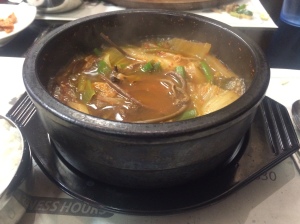Whether it was spent partying at the beach or chilling at home, spring break is–sadly–over.
A moment of silence, please.
Now, let’s be honest. Be it from drinking too much, going a little overboard on fast food or just over-doing it on Mom’s cooking, most of us probably lost sight of that New Year’s resolution over break.
We may be past the spring break-bod chase, but summer is coming fast. Swimsuits aside, eating a little better can make a big difference in how you feel.
Luckily, there are a few affordable places here in Auburn that can help you get back on track in the health department. Take a look at a few of my favorites:
1. Panera Bread
Fresh salads, soups and sandwiches make this place popular. My personal favorite is the Thai chopped chicken salad–the peanut sauce that comes with it is to die for! And for those of us looking to watch the calorie-intake, Panera provides nutritional information next to each item on the menu. (And also on it’s website).
This part is a little bit of a win-lose. You feel great about your salad, but then you know how many calories that bagel you had this morning really contains.
My rule is to save the bakery items for special occasions. Maybe it’s the southern girl in me, but I feel that a good grade, getting that job or finishing a tough week at school merits a quality treat.
2. Pita Pit
This downtown pita shop is basically a Subway with cooler options (sorry Subway, you’re still the sub king). You can choose a meat and sauce to be cooked on the flat top, add any or all of the fresh veggies you like and choose between a whole wheat or white pita.
There’s also the option of making your pita “fork-style,” which puts all of the sandwich fixin’s of your choice onto a bed of lettuce and cuts out the carbs. Voila! The best salad ever.
Go to the Pita Pit website to “Build a Pita” and see the nutrition information for your creation.
3. Taziki’s
This just-opened gem is located in the new strip between CVS and Barbecue House on South College Street. On of the Mediterranean Diet? Well, get your greek-food fix at this fast-casual eatery.
As a chain, the menu at Taziki’s is pretty standard at all locations. It features appetizers, soups, salads, wraps, entrees and more–all ready in a matter of minutes.
The hummus with baked, seasoned pita is an excellent starter to share with a few friends. It tastes incredibly fresh and puts packaged hummus to shame (sorry, Tribe Roasted Red Pepper).
My favorite meal is the mediterranean salad. It’s full of chickpeas, roasted red peppers, feta cheese and other goodies. On top of all that, it comes in at under 400 calories! (Did I mention that Taziki’s provides nutritional information, too?)
These are just three of my personal favorites. A few honorable mentions go to Smoothie King, Earth Fare, Moe’s Southwest Grill (with a few modifications) and good old Subway.
So let’s get back on that healthy-eating bandwagon and fight the post-spring break slump. Are there any good locations that I missed? Comment with your favorites.

